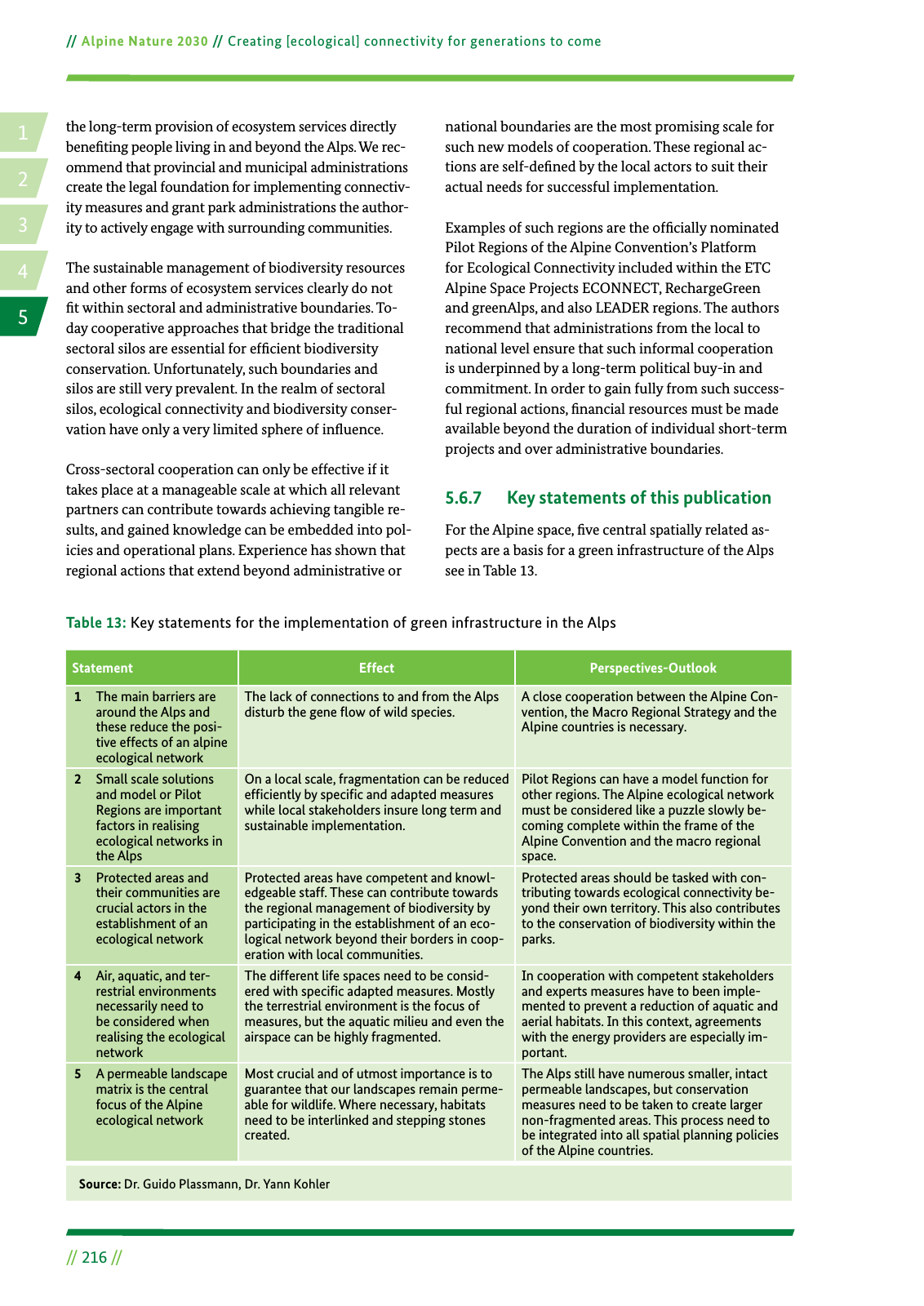14 2 5 3 Alpine Nature 2030 Creating ecological connectivity for generations to come 216 the long term provision of ecosystem services directly bene ting people living in and beyond the Alps We rec ommend that provincial and municipal administrations create the legal foundation for implementing connectiv ity measures and grant park administrations the author ity to actively engage with surrounding communities The sustainable management of biodiversity resources and other forms of ecosystem services clearly do not t within sectoral and administrative boundaries To day cooperative approaches that bridge the traditional sectoral silos are essential for ef cient biodiversity conservation Unfortunately such boundaries and silos are still very prevalent In the realm of sectoral silos ecological connectivity and biodiversity conser vation have only a very limited sphere of in uence Cross sectoral cooperation can only be effective if it takes place at a manageable scale at which all relevant partners can contribute towards achieving tangible re sults and gained knowledge can be embedded into pol icies and operational plans Experience has shown that regional actions that extend beyond administrative or national boundaries are the most promising scale for such new models of cooperation These regional ac tions are self de ned by the local actors to suit their actual needs for successful implementation Examples of such regions are the of cially nominated Pilot Regions of the Alpine Convention s Platform for Ecological Connectivity included within the ETC Alpine Space Projects ECONNECT RechargeGreen and greenAlps and also LEADER regions The authors recommend that administrations from the local to national level ensure that such informal cooperation is underpinned by a long term political buy in and commitment In order to gain fully from such success ful regional actions nancial resources must be made available beyond the duration of individual short term projects and over administrative boundaries 5 6 7 Key statements of this publication For the Alpine space ve central spatially related as pects are a basis for a green infrastructure of the Alps see in Table 13 Statement Effect Perspectives Outlook 1 The main barriers are around the Alps and these reduce the posi tive effects of an alpine ecological network The lack of connections to and from the Alps disturb the gene ow of wild species A close cooperation between the Alpine Con vention the Macro Regional Strategy and the Alpine countries is necessary 2 Small scale solutions and model or Pilot Regions are important factors in realising ecological networks in the Alps On a local scale fragmentation can be reduced ef ciently by speci c and adapted measures while local stakeholders insure long term and sustainable implementation Pilot Regions can have a model function for other regions The Alpine ecological network must be considered like a puzzle slowly be coming complete within the frame of the Alpine Convention and the macro regional space 3 Protected areas and their communities are crucial actors in the establishment of an ecological network Protected areas have competent and knowl edgeable staff These can contribute towards the regional management of biodiversity by participating in the establishment of an eco logical network beyond their borders in coop eration with local communities Protected areas should be tasked with con tributing towards ecological connectivity be yond their own territory This also contributes to the conservation of biodiversity within the parks 4 Air aquatic and ter restrial environments necessarily need to be considered when realising the ecological network The different life spaces need to be consid ered with speci c adapted measures Mostly the terrestrial environment is the focus of measures but the aquatic milieu and even the airspace can be highly fragmented In cooperation with competent stakeholders and experts measures have to been imple mented to prevent a reduction of aquatic and aerial habitats In this context agreements with the energy providers are especially im portant 5 A permeable landscape matrix is the central focus of the Alpine ecological network Most crucial and of utmost importance is to guarantee that our landscapes remain perme able for wildlife Where necessary habitats need to be interlinked and stepping stones created The Alps still have numerous smaller intact permeable landscapes but conservation measures need to be taken to create larger non fragmented areas This process need to be integrated into all spatial planning policies of the Alpine countries Table 13 Key statements for the implementation of green infrastructure in the Alps Source Dr Guido Plassmann Dr Yann Kohler

Hinweis: Dies ist eine maschinenlesbare No-Flash Ansicht.
Klicken Sie hier um zur Online-Version zu gelangen.
Klicken Sie hier um zur Online-Version zu gelangen.